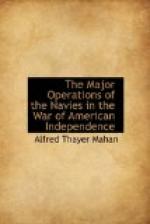In Barbados, Rodney received certain information that a Spanish squadron of twelve ships of the line, with a large convoy of ten thousand troops, had sailed from Cadiz on April 28th for the West Indies. The vessel bringing the news had fallen in with them on the way. Rodney spread a line of frigates “to windward, from Barbados to Barbuda,” to obtain timely warning, and with the fleet put to sea on the 7th of June, to cruise to the eastward of Martinique to intercept the enemy. The latter had been discovered on the 5th by a frigate, fifty leagues east of the island, steering for it; but the Spanish admiral, seeing that he would be reported, changed his course, and passed north of Guadeloupe. On the 9th he was joined in that neighbourhood by de Guichen, who was able to bring with him only fifteen sail,—a fact which shows that he had suffered in the late brushes quite as severely as Rodney, who had with him seventeen of his twenty.
Having evaded the British, the allies anchored at Fort Royal; but the Spanish admiral absolutely refused to join in any undertaking against the enemy’s fleet or possessions. Not only so, but he insisted on being accompanied to leeward. The Spanish squadron was ravaged by an epidemic, due to unsanitary conditions of the ships and the uncleanliness of the crews, and the disease was communicated to their allies. De Guichen had already orders to leave the Windward Islands when winter approached. He decided now to anticipate that time, and on the 5th of July sailed from Fort Royal with the Spaniards. Having accompanied the latter to the east end of Cuba, he went to Cap Francois, in Haiti, then a principal French station. The Spaniards continued on to Havana.




